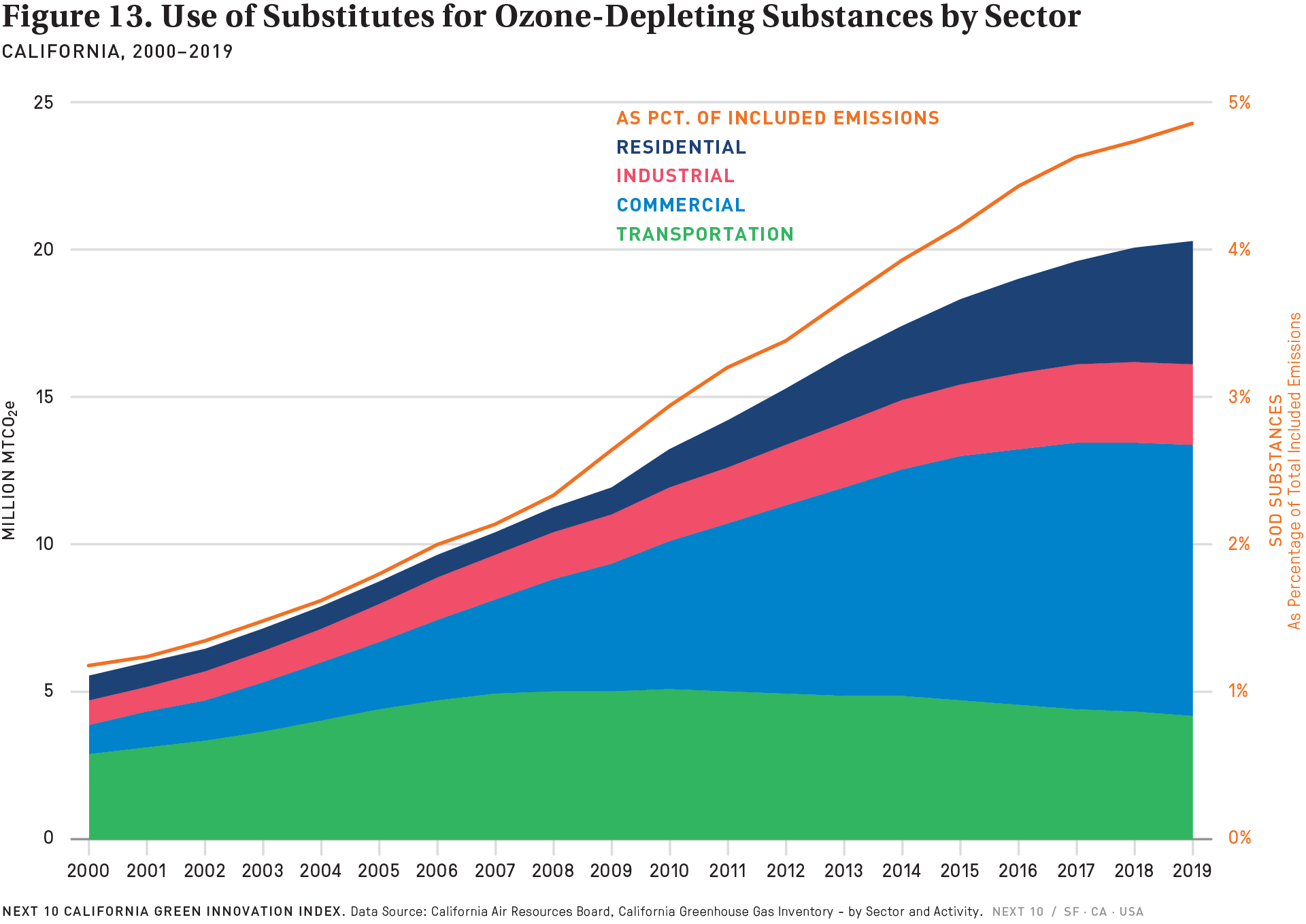Challenge
- Emissions from the use of Substitutes for Ozone-Depleting Substances (substitutes for ODS),15 which emit high global warming potential (GWP) gases such as hydrofluorocarbons (HFCs) and perfluorocarbons (PFCs), are the fastest-growing source of GHG emissions in California. In 2019, GHG emissions from substitutes for ODS from all economic sectors accounted for 4.9 percent of total included statewide emissions, up from 2018’s share (4.7%) and a considerably larger share compared to 2008 (2.3%) and 2000 (1.2%). Worldwide, emissions of high GWP gases from substitutes for ODS are rising, as they are used for purposes such as refrigeration and air conditioning.15,16,17,18,19
- For the Commercial and Industrial sectors, emissions from substitutes for ODS are associated with aerosols, fire protection, foams, solvents, and refrigeration and air conditioning activities, of which refrigeration and air conditioning activities are the main drivers of increase in GHG emissions from substitutes for ODS. The main refrigerants used for these sectors that contribute to the majority of the increase in GHG emissions are refrigerants R-125, R-134a, and R-143a,20 which have global warming potentials of 3,500 times, 1,430 times, and 4,470 times, respectively, of the GWP of carbon dioxide.21 In the residential sector, R-32a (with a GWP of 675 times of that of CO2) is commonly used alongside R-125 and R-134a (R-143a is not used in the residential sector). In 2019, GHG emissions from these four refrigerants across all economic sectors and activities totaled 19.149 MMTCO2e, up 1.0 percent compared to 2018. These four refrigerants accounted for 94.3 percent of GHG emissions from all substitutes for ODS in 2019. Moreover, GHG emissions from these refrigerants have all been rising over time, with R-125 rising the fastest (+43.7 percent from 2014 to 2019). Extreme heat from climate change will almost certainly increase the use of these refrigerants, ultimately resulting in even more GHG emissions. In 2020, California’s Air Resources board created regulations for commercial facilities with high-GWP refrigerant. Arguably the hallmark of these regulations is requiring all new equipment with more than 50 lbs. of refrigerant to use refrigerant with a GWP less than 150 starting in 2022. This is expected to cut emissions per facility by more than 90 percent.22 These regulations are the first step in California’s efforts to cut HFC emissions to 40 percent under 2013 levels by 2030. The federal American Innovation and Manufacturing Act, included in year-end legislation, provided additional support.23
15 Emissions occur when they are released into the atmosphere (e.g., from fire extinguishers or aerosol cans) or when they leak out of equipment such as refrigerators and air conditioning units.
16 Significant New Alternatives Policy, U.S. Environmental Protection Agency. Retrieved from: https://www.epa.gov/snap/global-emissions-substitutes-ozone-depleting-substances
17 The 1987 Montreal Protocol aimed to protect the Earth’s ozone layer by phasing out Ozone-Depleting Substances, but increased utilization of substitutes for ODS have resulted in an unintentional growth of GHG emissions. See: United Nations Environmental Program (2016). Treaties—The Montreal Protocol on Substances that Deplete the Ozone Layer. Retrieved from: https://ozone.unep.org/treaties/montreal-protocol/amendments/kigali-amendment-2016-amendment-montreal-protocol-agreed
18 The Kigali Amendment (adopted in 2016 and entered into force in January 2019) to the Montreal Protocol aims to address the emissions problem that substitutes of ODS have presented by phasing down global production of these substances and creating market certainty to allow growth of more environmentally friendly alternatives. President Biden had announced plans to ratify the Kigali agreement in April 2021.
19 While the Kigali agreement could help shape markets for these substances to reduce GHG emissions, at the state level, California has a number of programs aimed at reducing emissions from these substances, as outlined in the 2017 Short-Lived Climate Pollutant Reduction Strategy. See: Short-Lived Climate Pollutant Reduction Strategy. (March 2017.) California Environmental Protection Agency and California Air Resources Board. Retrieved from: https://ww2.arb.ca.gov/sites/default/files/2020-07/final_SLCP_strategy.pdf
20 The American Society of Heating, Refrigeration and Air-Conditioning Engineers (ASHRAE) Standard 34 assign refrigerant designations. For more information, see: https://www.ashrae.org/technical-resources/standards-and-guidelines/ashrae-refrigerant-designations
21 GWP values are based on AR4 100-year GWP values. A list of refrigerants and the associated GWPs are available at California ARB’s webpage on High-GWP Refrigerants: https://ww2.arb.ca.gov/resources/documents/high-gwp-refrigerants
22 California Approves Sweeping New Refrigerant Rules. Michael Garry. December 11, 2020. Hydrocarbons. Retrieved from: https://hydrocarbons21.com/articles/9858/california_approves_sweeping_new_refrigerant_rules
23 AIM Act. US EPA,
Retrieved from https://www.epa.gov/climate-hfcs-reduction/aim-act
